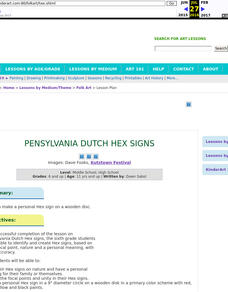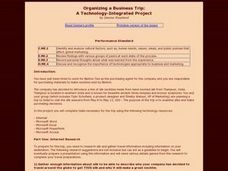Curated OER
Pennsylvania Dutch Hex Signs
Sixth graders identify and create Hex signs, based on unity, focal point, nature and a personal meaning,
Curated OER
The Hundred Penny Box
Students analyze the advantages of regular saving and how savings grow with compounding. After reading the story "The Hundred Penny Box", students define the terms "interest," "interest rate," and "compounding." Through several...
Curated OER
Kermit the Hermit
Students consider money management. In this personal finances instructional activity, students read Kermit the Hermit and discuss what was done with the unexpected money that Kermit received. Students examine methods of saving money and...
Curated OER
Screen printing - Positive-Negative shape - Paper stencils
Pupils explore materials and experiment with stencil process. Students study positive verses negative shape. They experiment with color planning and learn what happens when colors overlap. They work with personal symbols and/or...
Curated OER
Organizing a Business Trip: A Technolgy-Integrated Project
Pupils research the Internet to gather information about silk and make travel arrangements for a business trip. They create a memo to participants, create a database of suppliers, a letter to suppliers, design company letterhead and fax...
Curated OER
Luisa Diogo
In this famous person worksheet, students read a passage about Luisa Diogo and then complete a variety of in-class and homework activities to support comprehension, including partner interviews, spelling, cloze, synonym matches, and...
Curated OER
The Business of Interest
Students learn about finance and money management and use math to solve problems, communicate, and explore real life situations as they deal with banks. In this financial management lesson, students apply their math skills to real life...
Curated OER
The Hundred Penny Box
Students compare how people save money in financial institutions, after reading the story, The Hundred Penny Box. They analyze the advantages of regular saving and how savings grow with compounding.
Council for Economic Education
Timing Is Everything
Learners discuss the incentives and opportunity costs of spending vs. saving. They follow an interactive website which shows them the how much money they could end up with by saving instead of spending.
Curated OER
Spend, Save, Invest or Donate (9-12)
Students explore the concept of personal finance. In this philanthropy lesson, students examine decisions they make about money as they discover the definitions of philanthropy, resources, scarcity, choice, benefits, costs, opportunity...
Curated OER
Why Plan Meals?
Learners investigate methods that families use for planning meals. In this nutrition lesson, students play a game that requires them to plan and pay for nutritious meals
Curated OER
The Appliance of Science
Students delve into science fiction. In this Doctor Who instructional activity, students discuss the success of the British television show and then create pieces of writing and art that characterize Doctor Who. Students also visit...
Curated OER
My Dream Home
Students investigate the concept of a dream home and create an architectural drawing of it. They design the home with a projected budget of $500,000. They research different designs with the intent of pulling ideas for their design....
Curated OER
PAY CREDIT WHEN CREDIT IS DUE
Students learn about credit cards and scores and how to and not to use them. In this financial concept lesson, students are given hypothetical scenarios where they are able to apply learning's to given situations as they figure rates,...
Curated OER
Scoring a Financial Education
Students explore the concept of money management. In this money management lesson, students read an article about students taking a finance course in high school and college. Students discuss the importance of money management. Students...
Curated OER
Spend, Save or Donate
Young scholars identify the difference between spending, saving, and donating. They brainstorm reasons to give and options to donate. They sing a song about donating to charity.
Curated OER
Financial Literacy - Debt and Poor Money Management
Learners review responsibilities people have of their own finances, consequences of poor money management, excessive debt, and bankruptcy.
Curated OER
Shopping!!!
Students explore money management. In this financial awareness instructional activity, students are given an amount of money and a sheet of objects to choose from to buy. Students choose only five objects they can afford to "buy."
Curated OER
Keeping Track of Our Money
Second graders complete activities to learn how to manage money. In this managing money lesson plan, 2nd graders read the book How the Second Grade Got $8,205.50 to Visit the Statue of Liberty and complete two related worksheets.
Curated OER
There's No Business Like Bank Business
Students participate in a role play where they see how a bank works and how interest is paid by having money in the bank. In this bank lesson plan, students operate a bank and learn about saving, accounts, deposits, withdrawals,...
Curated OER
All Aboard!
Learners are placed in the position of the person who orders supplies for the ship. They calculate quantities required for a variety of items, and then to convert such quantities into dollars.
Curated OER
Watershed Analysis
Students conduct a regional watershed analysis of an area of their choosing. Using on-line data and their personal knowledge of the area, they determine the annual hydrologic budget and teach the class about "their" watershed.
Curated OER
Magazine Sales Talks
Students role-play to determine the best types of magazines that should be purchased for their media center. They create a sales presentation for a particular magazine in small groups. As they listen to each presentation they evaluate...
Curated OER
Bank Comparison Activity
Pupils experience the responsibility of finding a bank that fits their needs. They describe the role of planning and maintaining a balanced budget. Students view brochures from various banks or websites to various banks.

























